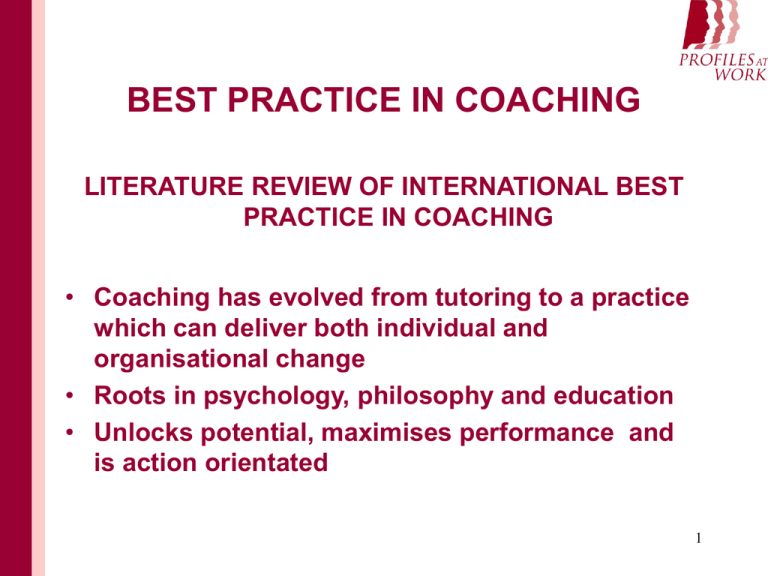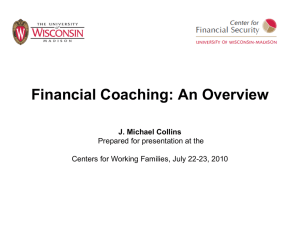BEST PRACTICE IN COACHING Who is coaching?
advertisement

BEST PRACTICE IN COACHING LITERATURE REVIEW OF INTERNATIONAL BEST PRACTICE IN COACHING • Coaching has evolved from tutoring to a practice which can deliver both individual and organisational change • Roots in psychology, philosophy and education • Unlocks potential, maximises performance and is action orientated 1 BEST PRACTICE IN COACHING Who is coaching? • • • • • Two global surveys (ICF and Sherpa Coaching) One UK Study (Acuity) 30,000 coaches operate globally Highest % in the US - 50.6% 10% in UK, 9.5% in Canada, 6.5% in Australia, 4.2% in France, 2% in Sweden • 17% in rest of the world including Ireland 2 BEST PRACTICE IN COACHING Who is coaching? (cont) • • • • • 60% aged between 46 and 65 86.4% coaching for less than 10 years 53% have advanced degrees (Masters or PHD) 88.2% have at least a Batchelor’s Degree As it is a relatively new area, its future success will be highly correlated with ongoing coach specific training and development 3 BEST PRACTICE IN COACHING Areas of Coaching- emerging trends • Significant increase in coaching as a leadership development tool • Coaching to address a specific problem has reduced from 37% to 32% • Executive coaching is offered to people in transition, promotions, transfers and new hires • Significant increase in developing a coaching style of leadership • Coaching also offered to new hires, talent and maternity cover. 4 BEST PRACTICE IN COACHING Areas of Coaching – emerging trends (cont) • • • • Growth of performance coaching Involves high performers Organisational development tool 3 most popular areas from the ICF study: Leadership (58.1%); Executive (57.8% and Business/Organisations (53.6%) 5 BEST PRACTICE IN COACHING Coaching Methodologies • 49% of executive coaching is in-person • 72% of executive coaches believe it is the most effective methodology • 92% of HR professionals and coaching clients believe inperson delivery is the most effective methodology • 40% of executive coaching takes place over the phone (many of these companies have less than 10 employees) 6 BEST PRACTICE IN COACHING Coaching Methodologies • Use of webcam and email have not been notably effective to date • Move towards more regular and structured meetings • Fixed length engagements • Use of psychometric tools (360 degree feedback) • Methodologies continue to evolve • Whole brain thinking – e.g. picture drawing • Use of drama in leadership coaching 7 BEST PRACTICE IN COACHING Executive Coaching: Regular meetings between a business leader and a trained facilitator, designed to produce positive changes in business behaviour in a limited time frame’ (Sherpa 2008) 8 BEST PRACTICE IN COACHING Executive Coaching • Move from problem solving and stigma of ‘career saves’ • Executive and leadership coaching now viewed as a pro-active strategy • Marks the grooming of an up and coming leader! 9 BEST PRACTICE IN COACHING Executive Coaching Strong correlations between leadership development and executive coaching (Hernez – Broome (2004) Outcomes: • Managers more focused on goals • More successful in achieving them • New learning and behaviour was more closely related to their roles as leaders and managers 10 BEST PRACTICE IN COACHING Executive Coaching Outcomes (cont) • The development of a culture of understanding, caring, exploration, open dialogue and improved business practices. (Turner 2004) • Specific skill development e.g. reflective learning skills; giving and receiving feedback; learning through action; team building, change management and leadership 11 BEST PRACTICE IN COACHING Best Practice ‘Professional standards, coach specialities and coaching niche areas will further evolve and change as coaching continues to establish itself as a recognised, stand alone profession.' Zeus and Skeffington 2002) 12 BEST PRACTICE IN COACHING 6 Areas of Effectiveness (Bush 2004) • Client is motivated and committed to the coaching process • They are working with a seasoned coach with whom there is positive rapport • The coaching engagement is supported by a structured process and focused on development • The profile of the coach should include the following: background, experience, expertise, roles, personal qualities and including others in the coaching process 13 BEST PRACTICE IN COACHING Six Areas of Effectiveness (cont) • Results are achieved which benefit the client • There is a recognition that effective coaching involves sharing responsibility between the three stakeholders; client, coach and organisation • Stakeholder roles elaborated (pg 6) 14 BEST PRACTICE IN COACHING Best Practice in Executive Coaching (Rock 2005) • • • • • Linking it to organisational goals and strategies Careful choosing of an appropriate coaching model Managing the entire process for consistency and quality Building a team of quality, screened coaches Preparing staff in advance and not forcing anyone to engage in coaching 15 BEST PRACTICE IN COACHING Best Practice in Executive Coaching (Rock 2005) (cont) • • • • • Providing strong organisational support Ensuring coaches are grounded in the companies culture Allowing each coaching relationship to follow its own path Ensuring there are documented feedback loops Building measurement and assessment into the process 16 BEST PRACTICE IN COACHING • Internal Coaches – employees who provide services to colleagues • External coaches – independent service providers • More than two out of three organisations who responded to the Sherpa study use a combination of internal and external providers. • One in ten relies exclusively on external providers 17 BEST PRACTICE IN COACHING CIPD Study (2005) Criteria for selecting coaches: • • • • • • • The right cultural ‘fit’ Personal style A positive track record A structured approach Relevant qualifications Adherence to professional standards Evidence of supervision 18 BEST PRACTICE IN COACHING Supervision ‘ Professional supervision as opposed to management supervision A time and space to reflect on ones work with either a senior colleague, in a led group, or with a number of peers (Bluckert 2006) 19 BEST PRACTICE IN COACHING Benefits of Internal Coaches • When knowing the company culture, history and politics is critical • When easy availability is desired • When it is necessary to build up high levels of personal trust over a period of time • When keeping costs under control 20 BEST PRACTICE IN COACHING Benefits of External Coaches • • • • Providing sensitive feedback to senior business leaders When there are political reasons When bringing specialised expertise When individuals are concerned about ‘conflicts of interest’ and whether confidentiality will be preserved • When providing a wider range of ideas and experience • When it is important for an organisation to see external coaches as less likely to judge and are perceived to be more objective 21 BEST PRACTICE IN COACHING Best Practice and ROI • • • • • • • • Mc Govern et. al (2001) ROI of 5.7 times initial investment from a coaching programme Metrix Global (2001) 529% return on investment BMW, Fortune Magazine – ROI quantified Sherpa study, Pfeiffer (2004); Acuity Coaching (2008); Schlosser et al. (2006) – all involved in conducting research on ROI from coaching. All involved in developing templates to capture ROI from coaching Overall findings suggest there are significant opportunities to gain a return on investment when executive coaching is delivered well. Returns are both tangible and intangible 22 BEST PRACTICE IN COACHING Coaching Culture • • • Coaching cannot be effective if conducted outside the context of a coaching culture A coaching culture exists ‘where coaching is the predominant style of managing and working together, and where commitment to grow an organisation is embedded in a parallel commitment to grow the people in the organisation’ (Clutterbuck and Megginson 2005) Coaching is that conversation which creates the new leadership culture, (it should) not (be used) as a technique within the old culture. (Everard and Selman 1989) 23 BEST PRACTICE IN COACHING Coaching Culture (cont) How to establish a coaching culture (Clutterbuck and Meggison 2005) • Ensuring managers have at least the basic skills of coaching • Equiping all employees with the skills to be coached effectively • Providing an advanced coaching skills programme for senior managers • Providing opportunities to review good coaching practices 24 BEST PRACTICE IN COACHING How to establish a Coaching Culture (Clutterbuck and Meggison 2005) • Recognising and rewarding managers who demonstrate good coaching • Measuring and providing feedback on the quality, relevance and accessibility of coaching • Ensuring top management provide strong, positive role models • Identifying cultural and systems barriers to developmental behaviours • HR practitioners can track how much the organisation is pervieved to support development and coaching activity in a variety of ways including employee attitude surveys • Creating a coaching culture generally involves implementing a long term strategic organisational development programme in an organisation 25 BEST PRACTICE IN COACHING Summary • • • • • • Coaching is increasing at all levels within organisations It has moved from ‘tutoring’ to a role which aims to transform organisations and the individuals working within them It is seen to be a leadership development tool Examples of good practice have been identified ROI has been identified It only works well within organisations who have developed coaching cultures 26 BEST PRACTICE IN COACHING Over to You NEXT STEPS!!! 27





